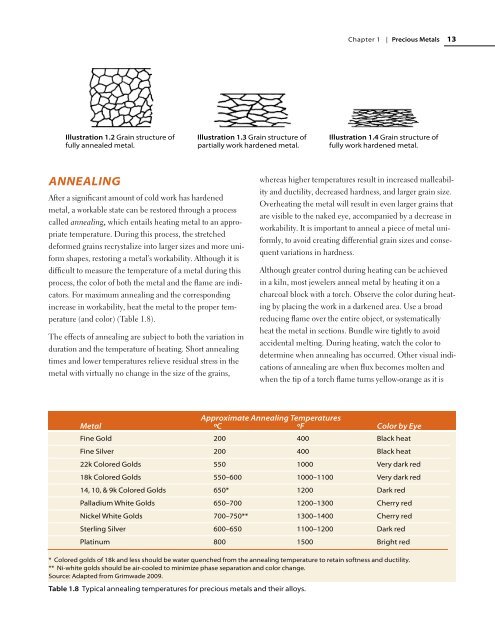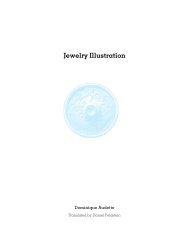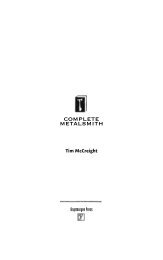Professional Jewelry Making - Brynmorgen Press
Professional Jewelry Making - Brynmorgen Press
Professional Jewelry Making - Brynmorgen Press
Create successful ePaper yourself
Turn your PDF publications into a flip-book with our unique Google optimized e-Paper software.
Illustration 1.2 Grain structure of<br />
fully annealed metal.<br />
AnneAlIng<br />
After a significant amount of cold work has hardened<br />
metal, a workable state can be restored through a process<br />
called annealing, which entails heating metal to an appropriate<br />
temperature. During this process, the stretched<br />
deformed grains recrystalize into larger sizes and more uniform<br />
shapes, restoring a metal’s workability. Although it is<br />
difficult to measure the temperature of a metal during this<br />
process, the color of both the metal and the flame are indicators.<br />
For maximum annealing and the corresponding<br />
increase in workability, heat the metal to the proper temperature<br />
(and color) (Table 1.8).<br />
The effects of annealing are subject to both the variation in<br />
duration and the temperature of heating. Short annealing<br />
times and lower temperatures relieve residual stress in the<br />
metal with virtually no change in the size of the grains,<br />
Illustration 1.3 Grain structure of<br />
partially work hardened metal.<br />
whereas higher temperatures result in increased malleability<br />
and ductility, decreased hardness, and larger grain size.<br />
Overheating the metal will result in even larger grains that<br />
are visible to the naked eye, accompanied by a decrease in<br />
workability. It is important to anneal a piece of metal uniformly,<br />
to avoid creating differential grain sizes and consequent<br />
variations in hardness.<br />
Although greater control during heating can be achieved<br />
in a kiln, most jewelers anneal metal by heating it on a<br />
charcoal block with a torch. Observe the color during heating<br />
by placing the work in a darkened area. Use a broad<br />
reducing flame over the entire object, or systematically<br />
heat the metal in sections. Bundle wire tightly to avoid<br />
accidental melting. During heating, watch the color to<br />
determine when annealing has occurred. Other visual indications<br />
of annealing are when flux becomes molten and<br />
when the tip of a torch flame turns yellow-orange as it is<br />
Approximate Annealing Temperatures<br />
Metal ºC ºF Color by Eye<br />
fine Gold 200 400 Black heat<br />
fine Silver 200 400 Black heat<br />
22k colored Golds 550 1000 Very dark red<br />
18k colored Golds 550–600 1000–1100 Very dark red<br />
14, 10, & 9k colored Golds 650* 1200 Dark red<br />
Palladium White Golds 650–700 1200–1300 cherry red<br />
Nickel White Golds 700–750** 1300–1400 cherry red<br />
Sterling Silver 600–650 1100–1200 Dark red<br />
Platinum 800 1500 Bright red<br />
* colored golds of 18k and less should be water quenched from the annealing temperature to retain softness and ductility.<br />
** Ni-white golds should be air-cooled to minimize phase separation and color change.<br />
Source: adapted from Grimwade 2009.<br />
Table 1.8 Typical annealing temperatures for precious metals and their alloys.<br />
chapter 1 | Precious Metals 13<br />
Illustration 1.4 Grain structure of<br />
fully work hardened metal.




